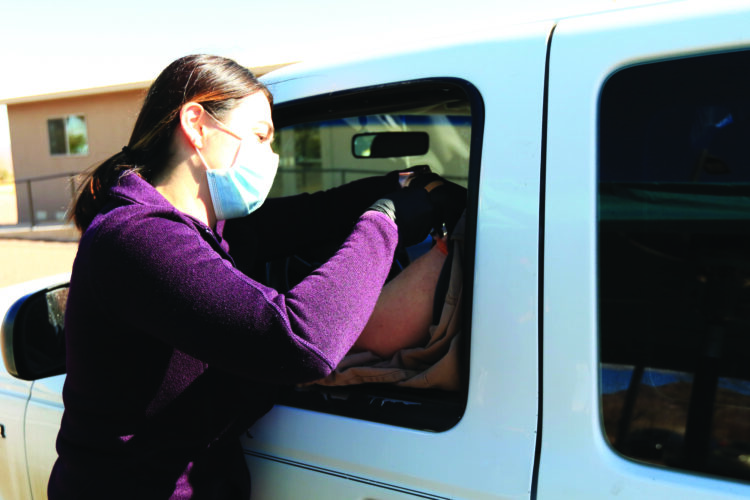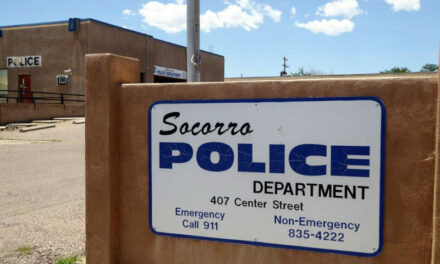
Positive Outcomes nurse Tara Hall administers a COVID-19 vaccine on Feb. 4 at the Socorro Rodeo and Sports Complex.
Caitie Ihrig | El Defensor Chieftain
Despite seemingly low daily infection numbers in the two-week period between Jan. 26 through Feb. 8, the New Mexico Department of Health last week moved Socorro County back to Red in the state’s Red to Green framework. The Red status results in once again limiting shopping for local businesses and no more indoor dining for restaurants. That is, at least for the current 14-day period, which ends Tuesday, Feb. 23.
For the two weeks previous to Jan. 10, Socorro’s business sector was allowed some breathing room as a result of its Yellow status, but on Feb. 10 DOH slipped the county’s COVID-19 risk level back to Red. The reclassification for Socorro was probably spurred by a one day spike of 17 reported cases on Feb. 3.
As of Tuesday, the cumulative cases for Socorro County is 1,196 since the beginning of the pandemic.
Socorro County had no positive cases on Tuesday.
The Red to Green system is also broken down into zip codes. Three zip codes in Socorro County are Red: 87062, 87801, and 87825. The one Yellow zip code is 87823.
The two key health metrics that are used to determine where a county sits within the tiered framework are the percapita incidence of new COVID-19 cases, and average COVID-19 test positivity over a statistically meaningful period of time.
According to DOH, these are the same metrics the state has used to classify counties for the purposes of gauging the risk level for limited public school reopenings and limited nursing home visitations.
Defined as “high risk,” counties at the red level have a new COVID-19 case incident rate of greater than 8 cases per 100,000 inhabitants during the most recent two-week period and an average percent of positive COVID-19 test results over the most recent 14-day period greater than 5 percent.
Socorro County’s current positivity rate stands at 6.26 percent.
Neighboring Sierra and Catron counties have gone green with 1.66 percent positivity for Sierra, and 1.69 percent for Catron.
The more populous Valencia County to the north has earned itself a yellow status with 4.26 percent positivity.
The move from yellow back to red means local businesses will have to curtail the number of customers allowed inside at one time and restaurants will have to once again close their doors to indoor dining.
What this means between now and next Wednesday:
- Food and drink establishments: No indoor dining permitted; 25 percent of maximum capacity for outdoor dining; any establishment serving alcohol must close by 9 p.m. each night
- Essential retail spaces, including grocery stores, supermarkets, food banks, and farmers’ markets are limited to 25 percent occupancy.
- Close-contact businesses such as barbershops and hair salons still are limited to 25 percent of maximum capacity or 10 customers at one time, whichever is smaller.
- Non-retail essential businesses have no capacity restrictions but operations must be limited to only those absolutely necessary to carry out essential functions
- All other businesses are limited to 25 percent of maximum capacity or 75 customers at one time, whichever is smaller.
- Houses of worship must limit indoor religious services to 25 percent of the maximum capacity..
- Places of lodging are limited to 40 percent of maximum occupancy for those that have completed NM Safe Certified training. However, on Saturday, DOH temporarily suspended COVID-19 restrictions on lodging capacity due to extreme weather conditions and road closures. While all other restrictions remained in place, occupancy limits were determined by what the local Fire Marshall has previously determined. The statement from the New Mexico Department of Health said it “realizes that road conditions may be dangerous and encourages people to stay home or in their present shelter if possible. Lodging management should use their best judgment on when it is appropriate to open to travelers who are stranded or in peril … “
- Outdoor recreational facilities such as golf courses, youth programs, and youth livestock shows remain limited to 25 percent of maximum capacity.
- Close-contact recreational facilities include indoor movie theaters and museums remain closed.
- Mass gatherings are limited to five persons or 40 vehicles, versus the previous five persons or 40 vehicles.
Traveling restrictions for the most part have eased up considerably. Effective Thursday, Feb. 11, the state no longer requires self-quarantine for visitors or New Mexicans arriving into the state from “high-risk” states or states with a five percent positivity rate or greater over a seven-day rolling average, or a positive test rate greater than 80 per 1 million residents.
Visitors from anywhere outside of the state will instead be strongly advised to self-quarantine for a period of 14 days and to seek out a COVID-19 test upon their arrival in or return to New Mexico.
Previously the state had required visitors or arrivals from “high-risk” states to physically separate from others in a residence or place of lodging for at least 14 days from the date of their entry into New Mexico or for the duration of their presence in the state, whichever is shorter. As of Feb. 9, only Hawaii was deemed a “low-risk” state, defined as a state with a five percent positivity rate or lower over a seven-day rolling average and a positive test rate lower than 80 per 1 million residents.
The tiered color-coded county-by-county COVID-19 risk system went into effect on December 2 and was extended by Gov. Michelle Lujan Grisham on January 29. The statewide mask mandate remains in place.



















